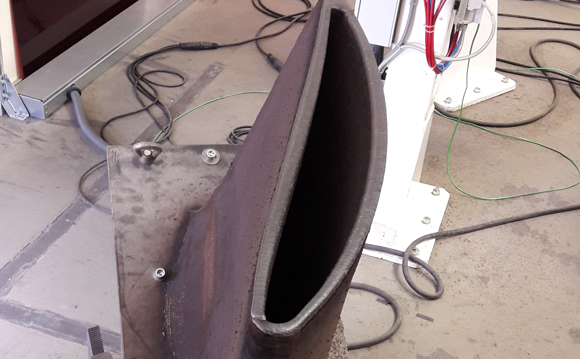Metal Additive Manufacturing enables ‘world’s first’ hollow propeller blade
February 13, 2019

The hollow propeller blade, produced using WAAM by Naval Group and Centrale Nantes (Courtesy Naval Group)
Naval Group, Paris, France, and Centrale Nantes, Nantes, France, have collaborated on the metal Additive Manufacturing of the first demonstrator model of hollow propeller blades as part of European H2020 project on the Realization and Demonstration of Advanced Material Solutions for Sustainable and Efficient Ships (RAMSSES1). Funded by the European Commission, this collaborative programme aims to reduce the environmental impact of ships.
Centrale Nantes and Naval Group are taking the lead within this project on the production of innovative propeller demonstrators to improve the operational capabilities of ships. In order to improve vessel propulsion, the partners are using Additive Manufacturing to design large parts including propellers of six metres in diameter, which could not be produced using traditional manufacturing technologies.
The Wire Arc Additive Manufacturing (WAAM) process allows for the AM of large parts and the production of propellers with more complex geometry. The one-third scale hollow blade demonstrator, representative of a container ship propeller, was additively manufactured in stainless steel in less than one hundred hours, and is said to weigh about 300 kg. The team stated that weight gains of over 40% will be achievable by this method compared to conventional processes.
Sirehna, a Centrale Nantes spin-off and subsidiary of Naval Group, is piloting the blade design in order to improve propeller energy efficiency and reduce their environmental impact. Sirehna’s work has reportedly led to an overall optimisation of blades in terms of efficiency and endurance, but also a significant reduction in radiated noise and vibrations. Reducing the environmental footprint linked to propulsion, as demonstrated in the H2020 RAMSSES project case study, is a challenge for all types of vessels, and particularly for large container ships.
Naval Group’s Patrice Vinot, Propeller Package Manager for the RAMSSES project, commented on the challenges of Additive Manufacturing for such an application. “Although Additive Manufacturing is increasingly present in industry, the programming and design of complex parts, such as propeller blades for ships, represents a considerable challenge for our teams and our partners,” he stated.
“The potential of the process revealed by this new case study means that we now anticipate unparalleled performance for the propellers of tomorrow. Taking part in projects such as RAMSSES and coordinating our network of academic and industrial partners will allow us to bring 3D printing into shipyards for the long term.”
Professor Jean-Yves Hascoët, head of the Rapid Manufacturing Platform at Centrale Nantes and international expert in Additive Manufacturing, added, “Additive Manufacturing has been developed over the last thirty-five years on the Rapid Manufacturing Platform. All these years of research come to fruition through a project like RAMSSES, which represents a real transfer of our technologies into an industrial environment.”
RAMSSES is a forty-eight month collaborative programme incorporating twenty-one work packages and thirty-seven partners from twelve countries, including key shipyards (Damen, Meyer Werft, Chantiers de l’Atlantique, Naval Group and more) and European maritime research laboratories (such as TNO in The Netherlands and the Research Institute of Sweden).
















